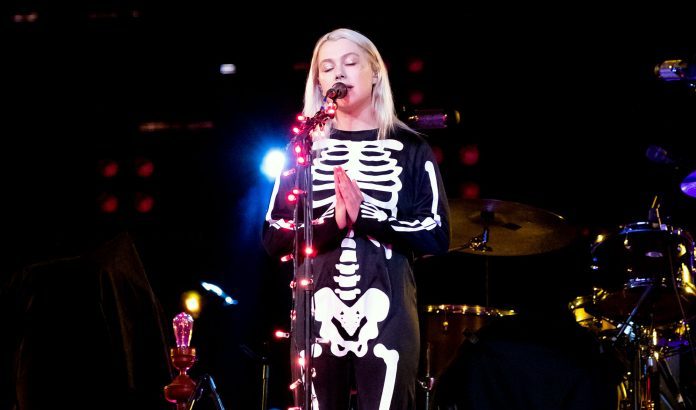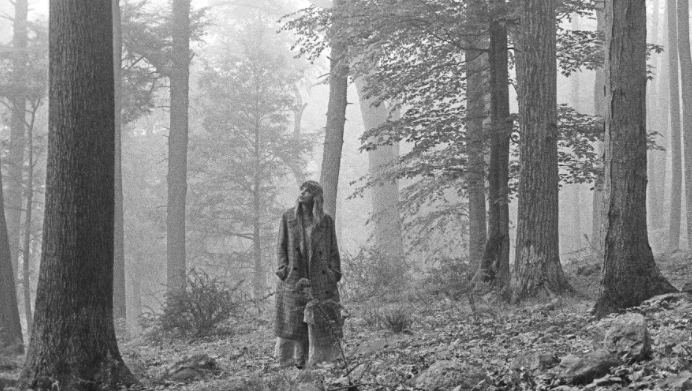When there’s a severe thunderstorm warning in Detroit, you’d naturally want to stay inside. But when there’s a severe thunderstorm warning in Detroit and Phoebe Bridgers is scheduled to perform, outside, at the same time… you’d naturally ask yourself: ‘what’s a little rain?’ and get into that car anyway.
At least, that’s what I did Tuesday night when I made the 45 minute drive from Ann Arbor to Detroit and watched some very ominous clouds roll in with me. By the time I reached the Aretha Franklin Amphitheater, a gorgeous outdoor venue nestled into the banks of the Detroit River, I’d almost convinced myself the storm would pass us. It was breezy and bright, and hundreds of people stood in line to show their tickets, almost like a Michigan game day, if Michigan fans wore skeleton suits instead of maize.
“Oh, good, it’s covered,” my friend said when we were finally in, gesturing to the billowing white canopy above us. But the cover was no match for the rain. We turned to watch the opening electro-pop band, MUNA, for about half a song, until the storm began.
In what felt like an instant, lightning began to pepper the sky behind the stage, illuminating the river below. Then, the downpour began. The crowd screamed, and MUNA left the stage, replaced by the crew as they rushed to throw tarps on the equipment. Through the rain I realized: Bridgers had taken the stage too, tarp in hand. We cheered until she left with the crew, and that was the last we saw of her until two hours later when the sky finally cleared.
While we waited, the storm raged on the river, soaking us in spite of the canopy. The crowd screamed at each lighting sighting, which meant we were pretty much screaming the whole time. Finally, the tell-tale beat of “ I Gotta Feeling” pumped through the loudspeakers, signaling the start of a Phoebe Bridgers show. Then, Bridgers and her band were on stage, suited up in their classic skeleton jumpsuits, and the intro to “Motion Sickness,” from Stranger in the Alps, overtook the Black Eyed Peas.
On stage, Bridgers was a vision. While lighting still flashed behind her, she looked completely in-control, as if she herself was commanding the storm. Her soft, honest style of singing was even more powerful in person than on the recording as she transitioned into the lull of “Garden Song,” and we hummed along. “Kyoto,” on the other hand, sent the crowd into an uproar; a jarring change from her more melancholy music, its upbeat tune and catchy chorus was a highlight of the night.
Personally, I was most touched by “Punisher” and “Moon Song.” “Punisher” details Bridgers’ adoration for one of her biggest musical influences- the late indie-rock legend Elliot Smith, who died in 2003. “What if I told you I feel like I know you, but we never met?” Bridgers laments in the song’s chorus, and as we sang along, I could tell many in the audience felt as connected to Bridgers through her music as she did to Smith.
“Moon Song,” was ethereal, as lighting continued to flash in the background, and the crowd swayed along. A marriage proposal during “Savior Complex” stands out as another highlight; Bridgers was beside herself with amusement and glee.
“I Know the End” was, of course, reserved for last, and it was a spectacular finish. It crescendoed into an overwhelming burst of energy and sound, as Bridgers expertly shredded on her electric guitar, and even kissed her bass guitarist. When the crashing drums settled down, she ran off stage, but returned for a brief encore- a cover of Bo Burnam’s “That Funny Feeling.”
In my home in Ann Arbor that night, I put on “Punisher” before I fell asleep. And I’ve put it on every day since. “Everyone knows you’re the way to my heart,” Bridgers wrote about Smith, and how touched you can be by a stranger’s music. After that concert, I know how she feels







